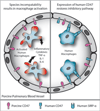Clinical lung xenotransplantation--what donor genetic modifications may be necessary?
- PMID: 22702466
- PMCID: PMC3775598
- DOI: 10.1111/j.1399-3089.2012.00708.x
Clinical lung xenotransplantation--what donor genetic modifications may be necessary?
Abstract
Barriers to successful lung xenotransplantation appear to be even greater than for other organs. This difficulty may be related to several macro anatomic factors, such as the uniquely fragile lung parenchyma and associated blood supply that results in heightened vulnerability of graft function to segmental or lobar airway flooding caused by loss of vascular integrity (also applicable to allotransplants). There are also micro-anatomic considerations, such as the presence of large numbers of resident inflammatory cells, such as pulmonary intravascular macrophages and natural killer (NK) T cells, and the high levels of von Willebrand factor (vWF) associated with the microvasculature. We have considered what developments would be necessary to allow successful clinical lung xenotransplantation. We suggest this will only be achieved by multiple genetic modifications of the organ-source pig, in particular to render the vasculature resistant to thrombosis. The major problems that require to be overcome are multiple and include (i) the innate immune response (antibody, complement, donor pulmonary and recipient macrophages, monocytes, neutrophils, and NK cells), (ii) the adaptive immune response (T and B cells), (iii) coagulation dysregulation, and (iv) an inflammatory response (e.g., TNF-α, IL-6, HMGB1, C-reactive protein). We propose that the genetic manipulation required to provide normal thromboregulation alone may include the introduction of genes for human thrombomodulin/endothelial protein C-receptor, and/or tissue factor pathway inhibitor, and/or CD39/CD73; the problem of pig vWF may also need to be addressed. It would appear that exploration of every available therapeutic path will be required if lung xenotransplantation is to be successful. To initiate a clinical trial of lung xenotransplantation, even as a bridge to allotransplantation (with a realistic possibility of survival long enough for a human lung allograft to be obtained), significant advances and much experimental work will be required. Nevertheless, with the steadily increasing developments in techniques of genetic engineering of pigs, we are optimistic that the goal of successful clinical lung xenotransplantation can be achieved within the foreseeable future. The optimistic view would be that if experimental pig lung xenotransplantation could be successfully managed, it is likely that clinical application of this and all other forms of xenotransplantation would become more feasible.
© 2012 John Wiley & Sons A/S.
Conflict of interest statement
David Ayares and Carol Phelps are employees of Revivicor Inc. No other author has a conflict of interest.
Figures



Similar articles
-
Pre-treatment of donor with 1-deamino-8-d-arginine vasopressin could alleviate early failure of porcine xenograft in a cobra venom factor treated canine recipient.Eur J Cardiothorac Surg. 2005 Jul;28(1):149-56. doi: 10.1016/j.ejcts.2005.02.042. Epub 2005 Apr 18. Eur J Cardiothorac Surg. 2005. PMID: 15982598
-
Report of the Xenotransplantation Advisory Committee of the International Society for Heart and Lung Transplantation: the present status of xenotransplantation and its potential role in the treatment of end-stage cardiac and pulmonary diseases.J Heart Lung Transplant. 2000 Dec;19(12):1125-65. doi: 10.1016/s1053-2498(00)00224-2. J Heart Lung Transplant. 2000. PMID: 11124485 Review.
-
Xenotransplantation of solid organs in the pig-to-primate model.Transpl Immunol. 2009 Jun;21(2):87-92. doi: 10.1016/j.trim.2008.10.005. Epub 2008 Oct 26. Transpl Immunol. 2009. PMID: 18955143 Review.
-
Progress and challenges in lung xenotransplantation: an update.Curr Opin Organ Transplant. 2018 Dec;23(6):621-627. doi: 10.1097/MOT.0000000000000582. Curr Opin Organ Transplant. 2018. PMID: 30234737 Review.
-
New concepts of immune modulation in xenotransplantation.Transplantation. 2013 Dec 15;96(11):937-45. doi: 10.1097/TP.0b013e31829bbcb2. Transplantation. 2013. PMID: 23851935 Free PMC article. Review.
Cited by
-
Simultaneous Overexpression of Functional Human HO-1, E5NT and ENTPD1 Protects Murine Fibroblasts against TNF-α-Induced Injury In Vitro.PLoS One. 2015 Oct 29;10(10):e0141933. doi: 10.1371/journal.pone.0141933. eCollection 2015. PLoS One. 2015. PMID: 26513260 Free PMC article.
-
Future prospects for tissue engineered lung transplantation: decellularization and recellularization-based whole lung regeneration.Organogenesis. 2014 Apr-Jun;10(2):196-207. doi: 10.4161/org.27846. Epub 2014 Jan 31. Organogenesis. 2014. PMID: 24488093 Free PMC article. Review.
-
Recent advances in understanding xenotransplantation: implications for the clinic.Expert Rev Clin Immunol. 2015;11(12):1379-90. doi: 10.1586/1744666X.2015.1083861. Epub 2015 Sep 1. Expert Rev Clin Immunol. 2015. PMID: 26548357 Free PMC article.
-
Cardiac Xenotransplantation: Challenges, Evolution, and Advances.JACC Basic Transl Sci. 2022 Jun 15;7(7):716-729. doi: 10.1016/j.jacbts.2022.05.003. eCollection 2022 Jul. JACC Basic Transl Sci. 2022. PMID: 35958689 Free PMC article. Review.
-
Bioprosthetic heart valves of the future.Xenotransplantation. 2014 Jan-Feb;21(1):1-10. doi: 10.1111/xen.12080. Epub 2014 Jan 21. Xenotransplantation. 2014. PMID: 24444036 Free PMC article. Review.
References
-
- Bryant LR, Eiseman B, Avery M. Studies of the porcine lung as an oxygenator for human blood. J Thorac Cardiovasc Surg. 1968;55:255–263.
-
- Kaplon RJ, Platt JL, Kwiatkowski PA, et al. Absence of hyperacute rejection in pig-to-primate orthotopic pulmonary xenografts. Transplantation. 1995;59:410–416. - PubMed
-
- Kamholz SL, Brewer RJ, Grijalva G, et al. Laboratory studies in cross-species lung transplantation. World J Surg. 1997;21:951–955. - PubMed
-
- Macchiarini P, Mazmanian GM, Oriol R, et al. Ex vivo lung model of pig-to-human hyperacute xenograft rejection. J Thorac Cardiovasc Surg. 1997;114:315–325. - PubMed
-
- Macchiarini P, Oriol R, Azimzadeh A, et al. Evidence of human non-alpha-galactosyl antibodies involved in the hyperacute rejection of pig lungs and their removal by pig organ perfusion. J Thorac Cardiovasc Surg. 1998;116:831–843. - PubMed
Publication types
MeSH terms
Grants and funding
LinkOut - more resources
Full Text Sources
Other Literature Sources
Medical
Research Materials
Miscellaneous

